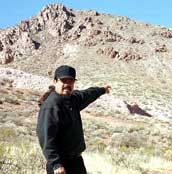| Depleted uranium (DU) penetrators made in
American munitions factories are tested at
a number of firing ranges to evaluate quality
and destructive power. When these radioactive
weapons age, they are discarded like ordinary
weapons. While investigating the impact of
DU on Gulf War veterans and communities near
factories, I also visited firing ranges and
disposal sites. People living in these areas
are struggling with environmental contamination
and health problems, a struggle made more
difficult by the thick walls behind which
the authorities hide the facts. (Story and photo by Akira Tashiro, senior
staff writer)
|
| Test firing of Radioactive Weapons Convinced by inside information |
"Entry prohibited. This is as far as
we go. That mountain in front is the firing
range," says Damacio Lopez (56), who
is wearing a black cap and sunglasses. He
handles the wheel carefully. "A patrol
car could come along any minute. You can
only take pictures from inside the car."
![]() Entry blocked by barbed wire
Entry blocked by barbed wire
We make a U-turn in front of the headquarters
of the Energetic Materials Research Test
Center affiliated with New Mexico Institute
of Mining and Technology. Lopez checks to
be sure no patrol cars are around, then drives
along a rough road lined with shrubs. He
parks in the shade of a tree not far from
the firing range. We climb fifty or sixty
meters up a crumbly hillside. From that height,
we look down on a barbed wire fence stretching
into the distance. At regular intervals,
fence signs warn, "NO TRESPASSING, PROHIBIDO
ENTRAR." About three kilometers (less
than two miles) to the east lies the town
of Socorro, population 8,000, its houses
fanning out into the desert.
We are about 125 kilometers (78 miles) south
of Albuquerque, New Mexico, and less than
50 kilometers (31 miles) northwest of Trinity,
where the first atomic test in human history
took place on July 16, 1945.
"The house where I was born and raised
is the one closest to the firing range,"
says Lopez, pointing in the direction of
his house.
The former pro-golfer of mixed Mexican, Hispanic,
and Indian ancestry now works for an NGO
(non-governmental organization). To escape
poverty, he joined the airforce at 17. At
22, after leaving the service in 1965, he
went to university where he played for the
golf club. In 1969, he turned pro and appeared
frequently in tournaments until 1985. Near
the end of that year he was injured in an
auto accident and returned to his hometown
to recuperate.
![]() Strong blasts and cracks in the walls
Strong blasts and cracks in the walls
"The tests began right after I arrived
in Socorro-tremendous explosions. It was
so bad we got cracks in our walls."
Lopez was so surprised, he attended a meeting
of the university's Board of Regents and
asked what the tests were and who was conducting
them. "They're nothing but tests of
simple conventional weapons." Surprised
to be confronted by questions no one had
asked before, the university authorities
gave carefully guarded answers.
Several weeks later, some cardboard boxes
were delivered to Lopez by workers at the
firing range. "They were full of contracts
and other documents exchanged between the
college and the companies manufacturing DU
munitions shells regarding the use of the
firing range and even the money involved."
![]() Confirmed by the president's insults
Confirmed by the president's insults
Lopez, who now understood that radioactive
weapons were being tested near his home,
went directly to the president of the university
to request a halt to the testing. He was
armed with plenty of evidence. The irate
president answered, "What's the matter
with you, boy? Don't you understand English?
It's depleted uranium. There's no radioactivity
so it doesn't make any hazard. You should
learn English."
The term "depleted" does mean "used
up" or "made empty," so when
many Americans hear it, they assume that
"depleted" uranium must not be
dangerous. To Lopez, however, the president's
words were an insult to Native Americans,
Mexicans, and Hispanics, the sort of discrimination
to which American society constantly subjects
them.
"It is no exaggeration to say that the
president's words changed my life."
That was the first step in Lopez' long journey
investigating the health effects of depleted
uranium.


Damacio Lopez points to the firing range. "It's hardly surprising that people in this town have inhaled DU particles." (Socorro, New Mexico)